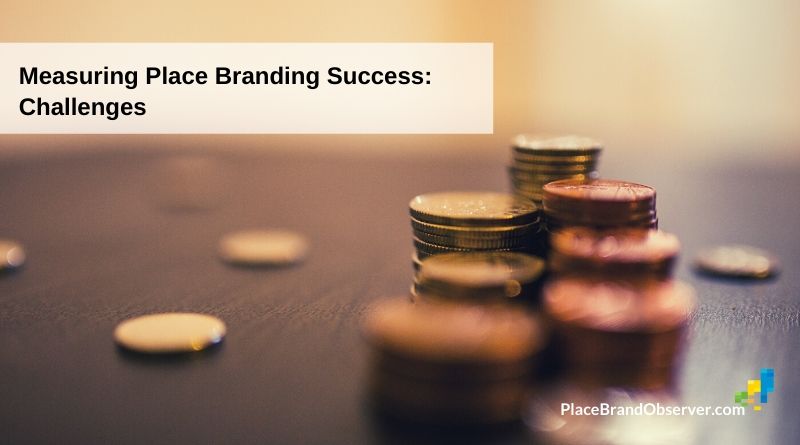Knowing what a place branding programme or a place marketing campaign has accomplished is important to determine its effectiveness. Depending on the objectives at hand, suitable success measurement methods can be deployed. But sometimes, success measurement is not as straight-forward as we’d like it to be.
In collaboration with Copenhagen Business School, we asked our panel of place branding specialists which challenges are the most common when measuring place branding effectiveness, and how to overcome those?
Here their answers (in alphabetical order – highlighted respondents are available for consulting, research or as speakers).
Our key takeaways:
- The effects of a place branding initiative may take years to come to fruition and hence measuring changes over time continuously could be problematic.
- Quantifying desired outcomes such as happiness, positive experiences, awareness or perception is difficult.
- Success measurement focused on economic, quantitative factors is tricky in that it’s difficult to determine causality: improvements might be due to other factors, not the place branding or -marketing effort.
- Each method has its limitations and thus no approach to success measurement is perfect.
- Setting clear KPIs is key to measuring success. Narrow it down and make those as precise as possible.
- Success measurement and evaluation can be expensive and the necessary funds need to be accounted for from the start.
Andrew Hoyne
When place branding and marketing fail, it’s usually because there was no clear criteria or clarity around goals and targets. This often occurs when cities dumb down the exercise to a logo and tagline instead of thinking of place branding as a strategic blueprint. What place branding and marketing should represent is a plan for overarching growth and development, something that cannot be achieved by an icon on marketing material. Be clear about your purpose and let that determine a very specific set of success metrics that are measurable.
Caio Esteves
The metric for place branding should be community happiness, now measurable, while for place marketing this metric is probably more linked to performance, although performance, inevitably, is also linked to the happiness of a positive experience in a certain place.
The challenge is to create more “human” methods of evaluation. How to measure the performance of an exciting experience in a place?
Migrating from a purely quantitative approach to a qualitative approach may be the first step.
Christopher Hire
We already have the means to measure this and have done so already. It’s available to anyone who commercially wishes to purchase, and involves data models that we have built for clients.
The worst way to measure it is nebulous brand techniques like impressions, uploads, clicks, recognition (e.g. those ‘have you seen advertisers’), etc.
Ed Burghard
The two big challenges are:
- Getting alignment on the meaningful attributes that truly define resident aspirations and enable them to thrive. The practical working number is under 30 attributes, and more often than not cluster analysis is used to understand the attribute connectivity.
- Educating decision-makers on how strategic choices around capital and infrastructure investment, as well as a public policy/program choices, impact place branding success. And enrolling those decision-makers in focusing on delivering long term sustainable improvement rather than scoring short term political points.
Efe Sevin
I will share two challenges: attention span and attribution.
We, as place branding scholars and practitioners, operate on the assumption that audiences – let it be residents, tourists, or even businesses – think about places critically, re-evaluate their opinions, and even change their behaviors based on newly acquired information. The reality is that audiences don’t think about places frequently, including their hometowns.
When we try to measure the success of our campaigns, we have two options. We can use designed surveys and prompt audiences to share their views. Or we can use organic social media data to see what audiences are thinking.
The former basically forces people to spit out answers. The latter is usually guided by extraordinary events, such as a touristic visit to a city or a policy discussion on hometowns. But in neither of these options, we can completely extract what people think about a given place because they usually just don’t think. Using a combination of surveys and social data, as well as longitudinal or constant monitoring studies, can help overcome these challenges.
The second challenge is about creating the causal link between place brands and place branding. The conversation around a place can be changed by many external factors. How can we attribute these particular changes to the actual campaign? In academia, we have a couple of answers for this question yet none is iron-clad. Logic models can help remedy the situation by linking inputs to outcomes to an extent. Yet, the complexity of place brands makes measurement a difficult endeavor.
Günter Soydanbay
Soydanbay Consulting / Speaker
The primary challenge of success measurement is ownership. Some place brands are orphaned right after launch. Without the backing of an influential sponsor, the project becomes stillborn, hence no measurement.
The second challenge is professional management. To be able to measure success, one must first manage the project properly. However, places resist hiring top marketing professionals like a corporation would do. As a consequence, of the surviving projects, some fall into no man’s land, hence no measurement.
The third challenge is accountability. Most place branding projects do not have clear KPIs. In the absence of clear objectives, the project manager does not have the incentive to track progress, for s/he is not held accountable.
Finally, there is the problem of noise in data. Place brands operate in higher systems. Cities are a part of a country; countries are a part of a region. The brand might be doing great while its parent country is dealing with a crisis. Or vice versa. For instance, during the Arab Spring, Tourism Turkey’s performance skyrocketed, not due to branding but opportune political conditions. So, removing the noise from data is a challenge.
Heather Skinner
One of the unresolved challenges concerns what happens when place branding efforts become too successful. Many different types of places are experiencing problems relating to their success in attracting unsustainable numbers of tourists, an issue that was highlighted when the ‘summer of overtourism’ became headline news in popular media in 2017.
Taking tourism out of the equation and by focusing more on those who live in and work in a place, in this context, there will remain challenges for success measurement in place marketing and branding if these efforts result in inequalities and the marginalisation or exclusion of certain social groups. Place marketing and branding efforts can also lead to the commodification of a place and its cultural heritage which can also lead to certain stakeholders becoming at best disinterested and at worst antagonistic towards success measurements.
To overcome all of the above, success measurement needs to be defined in an inclusive manner that takes into account the perspectives of all relevant stakeholder groups. Thus, it needs to undertake less top-down and more bottom-up approach, not only paying lip service to stakeholder engagement, but really including, involving, and actively listening to these different views and voices. In that way, success measurements for a place may be generated that is based more on quality of life, sustainability and sufficiency indicators rather than heavily or exclusively on economic growth.
Hjörtur Smárason
Scope Communications / Speaker profile
It is in the nature of place marketing and branding to have a very high number of variables, making it harder to measure and impossible to prove. The growth of the brand is based on the combination of thousands of things, although the overall development can be measured. The best way to overcome this challenge in measurement is to base the brand on a strong story and keywords and see how the growth of those is correlated to the growth of the place awareness.
Jeannette Hanna
Trajectory Brand Consultants / Speaker profile
It’s important to have both a qualitative and quantitative sense of attitude. What is the general sentiment regarding a place for residents and visitors? The trajectory is as important as a snapshot in time. Is the momentum trending toward positive or negative sentiments? Who are the influences? What’s emerging?
Natasha Grand
Measuring is a dedicated activity, so the first requirement is to have people, tools, time and budget in place. The team doing the measurement should be very fluent in the place brand identity to be able to see its offspring and iterations.
Robert Govers
Independent advisor/ Speaker/ Researcher
The complexity is to do with the fact that we’re dealing with different measurements in areas such as:
- Sustainable economic performance in tourism, investment, exports, talent attraction
- Community building, civic pride and resident satisfaction
- Stakeholder commitment
- Social media buzz
- International news media coverage
- On-brand project and product development
- On-brand communications
- Reputation
And that at various levels of:
- Impact
- Outcomes
- Outputs
It’s a complicated maze of potential success factors to monitor and for more on this, watch this.
Sebastian Zenker
Obviously, success measurement is problematic here as place marketing and branding are only partially responsible for success. It is much too complex to measure the hard-impact of marketing (due to the numerous amounts of other influencing factors).
I tell the cities often in regards to success: “if things do not develop well it was you – if things change into positive, it was the mayor”.
The three main problems are:
- Complexity: There are many different aspects and actors involved to create success. Therefore, it is nearly impossible to calculate the single effect of one part of it. To solve this problem, chaos theory suggests – for instance – rather think in a scenario-approach (calculating and forecasting effects without or a different place marketing effort).
- Little direct, but many indirect effects of our work: That means we are more often fuelling events and developments (increasing their impact), rather than having a direct effect. We must, therefore, focus more also on indirect measures.
- The time-effect: Many current initiatives will have an effect in a couple of years. Brand-image changes take a lot of time; moving decisions are often not immediately and place marketing often only fuels the seed of a decision. To solve this we need longer time-series and longitudinal studies.
Todd Babiak
I understand why there are off-the-shelf “products” to measure success in place marketing and branding. But in some ways, I think they harm our efforts. They tend to measure digital sentiment and they rarely give us the information we can use.
If we spend a pile more money on events, for example, there will be more social media activity and economic success. The question is: did those events pay for themselves, and was that social media activity about the event or was it about who we are – our brand? That takes a much harder look.
If we move from communications to action, it gives us something to measure. We can measure participation in projects we launch to bring our brand to life. We can measure our partners’ success, digging into the place brand component of that success – particularly when we look at labour, student, or investment attraction.
Andrea Lucarelli
The main challenge is linked to the one-size-fits-all measurement, which is presented in the form of indexes, used in a universal manner. Most of the time these are imposed on cities and regions or are adopted by cities and regions as inspiration for their place branding and marketing practices. Measurements risk becoming a “fetish” for cities and regions. This is the main problem for me.
Erling Fossen
It’s impossible to measure the outcome of place marketing in a meaningful way. Either you have to reduce your ambitions and, for example, count the number of foreign newspaper articles mentioning your city, together with buzz on social media. Or your city can gather all the major rankings worldwide, to see if there are any good results.
Greg Clark and Business of Cities, each year publish a State of the City report for Oslo, collecting around 200 global rankings. The politicians are happy, as long as we’re improving in major rankings within our prioritized areas – for example, green politics. And if your city is mentioned in 200 rankings, there will always be rankings where we are on the rise. It’s all about storytelling.
Gary Warnaby
Challenges of success measurement revolve around the problem of isolating the effect of marketing/branding activities from a variety of other issues that might impact on place performance, so having appropriate communications-oriented KPIs is crucial here.
Hila Oren
Some of the factors are subjective rather than objective. Indexes such as awareness and perception are not necessarily measured by numbers. For instance: Turkey’s 30M tourists don’t necessarily improve the country’s branding and Tel-Aviv with only 1M tourists has much stronger place branding.
To tackle this challenge, I would look more closely at other factors that are not currently defined as indexes but can give us a better idea of defining success in place branding. These need to be thought about and figured out.
Hong Fan
There are many challenges to success measurement in place marketing and branding. Because places are dynamic with changes happening every day. The challenge adds up as the geographical size of the place increases as there are more dimensions to be considered.
To add on, people have a different preference for places and they are attracted by different things in a place. Therefore, in my opinion, success measurement might be easier for destination branding as they are made to attract consumers from the very beginning. Statistics such as the number of tourists and revenue can be easily collected and studied.
I would suggest three ways to overcome the challenge:
- The goal of the marketing and branding effort must be specific, so is the target audience. Besides, marketing activities must be clearly designed with a focus.
- The place must have unique attractiveness, leading to focused marketing and branding objectives and thus making measurement simpler and more focused.
- Questionnaires should be distributed to both residents and visitors on a large scale before the marketing task and after the task, to compare the change in their awareness and recognition of places.
Jonathan McClory
Usually, it’s the budget. The methodologies – even if imperfect works-in-progress – are broadly there, but it’s a question of finding the resources required to pay for them. Doing proper measurement and evaluation is not cheap, so it’s often neglected.
Beyond that, the biggest challenge is linking branding initiative outputs, whether creative or actual policy changes, to impact over a short enough timeline to satisfy political demands on leaders. This is why measurement in the short, medium and long term is so important to demonstrate progress and keep the momentum going. Or if an initiative is not demonstrating impact, then to either change tack or simply end it in its current form.
Jordi de San Eugenio Vela
The challenge is, in my opinion, the development of a multidimensional measurement that is an indicator with a capacity to measure the improvement (or not) of any place beyond economic results. For example, the government of Bhutan has a critical indicator to measure the prosperity of the country: happiness.
José Pablo Arango
The main challenges in measurement are based on the goals and objectives that are proposed. You have to set goals that are measurable and consequently find a way to measure them.
Rebecca Smith
There are four key challenges we face in success measurement:
1) Quant vs. Qual: Measuring shifts in perception requires all stakeholders to grasp qualitative perception research. For officials used to defining success with quantitative metrics such as ‘bed nights’, ‘student numbers’, or ‘investment inflow’, trust in qualitative measures demands a substantial mindset shift and takes time and education.
2) Funding: Measurement research is often not part of the place marketing funding package or minimum spend is assigned to it. It can be very expensive to conduct qual research in some countries and it also demands stakeholders understand the need for international travel associated with the research. Research and travel are often frowned upon by public sector stakeholders who see this is an unnecessary or unproductive expense.
3) Project vs. ongoing: Stakeholders unfamiliar with brand tracking can often view measurement as a one-off project – something to be undertaken when a report or justification is required. Yet the true value is in measuring shifts over time, trend analysis and building the insights into your ongoing work plan.
4) Opinions over facts: Despite one’s best efforts to educate officials and stakeholders on the value of credible research and insights, the opinions of one or two high ranking officials can still be overwhelming and drive initiatives. You need conviction, thick skin, and a willingness to speak up to debate the opinions and ensure the work you do is taking you in the right direction.
Previous questions answered by the panel here.
You’d like to ask the panel a question? Get in touch!
Enjoyed this snapshot of expert views on challenges of success measurement in place branding and marketing? Spread the word!















